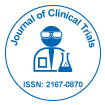
Journal of Clinical Trials
Open Access
ISSN: 2167-0870

ISSN: 2167-0870
Sara Majed Saab*, Ateeq Mohammad Algarni, Majed Ameen Saab, Rateb Abd Alrazak Daowd, Majed Abdulhadi Almograbi, Naeemah Yahiya Abdulkader, Khaled Abdulkarim Rakhil, Naif Mansour Alrashed, Raed Fahad Albusayyis, Buran Kheir Bismar, Yazeed Saad Alyousef and Eden Claire Celestra
Background: Many women develop uterine fibroids, which are benign but can cause discomfort such as pelvic pain, pressure and excessive menstrual bleeding. While they are not usually a major health concern, some studies indicate that larger fibroids could contribute to an increased risk of Venous Thromboembolism (VTE), including DVT and PE. VTE is often underdiagnosed, particularly in women with conditions like uterine fibroids, but it's still uncertain how much they contribute to the VTE risk. One possible explanation is that larger fibroids put pressure on major veins, such as the iliac veins or inferior vena cava, slowing blood flow and making clots more likely. The connection between symptomatic fibroids and VTE is something that needs more attention to improve patient care. Even though fibroids are quite common, there isn’t much research on how often VTE occurs in these patients, leaving an important gap in medical science.
Objectives: This study examines the occurrence of Venous Thromboembolism (VTE) in women with symptomatic uterine fibroids and its correlation with VTE risk. It also aims to explore strategies for managing and preventing VTE in this patient population.
Methods: This study, conducted between January 2023 and May 2024 in Riyadh, Saudi Arabia, uses a correlational descriptive approach to explore the risk of VTE in women with symptomatic uterine fibroids. Researchers reviewed medical records from an electronic healthcare database, a VTE dashboard and PACS, focusing on obstetric, medical and surgical patients to assess VTE risk and the effectiveness of prophylaxis. Data from 3,534 female patients aged 18 to 60 including 28 diagnosed with symptomatic fibroids were analyzed using SPSS, applying descriptive statistics and a two-tailed Pearson correlation test.
Results: A total of 12,757 admissions were recorded, with 3,534 female patients aged 18 to 60 meeting the study criteria. Among them, 1.5% (n=53) of women had a history of VTE, including one case of hospital-acquired pulmonary embolism, 28 (0.79%) were admitted with symptomatic uterine fibroids and 5 (17.86%) had a history of VTE. Statistical analysis revealed a significant correlation (r=0.115, p <0.001) between symptomatic uterine fibroids and VTE history, suggesting an increased risk in this group. Risk assessment showed that most fibroid patients fell into moderate to high-risk categories for VTE and preventive interventions, including pharmacological and mechanical prophylaxis, were administered accordingly. Surgical management was required in 85.71% of fibroid cases, with no recorded morbidity or mortality.
Conclusion: Women with symptomatic uterine fibroids seem to be more vulnerable to VTE, especially when dealing with larger or multiple fibroids as findings show a significant correlation between fibroids and VTE history. This emphasizes the importance of early detection, thorough VTE assessment and prophylactic measures for this population, advocating for greater awareness and improved management protocols.
Published Date: 2025-06-13; Received Date: 2025-05-11